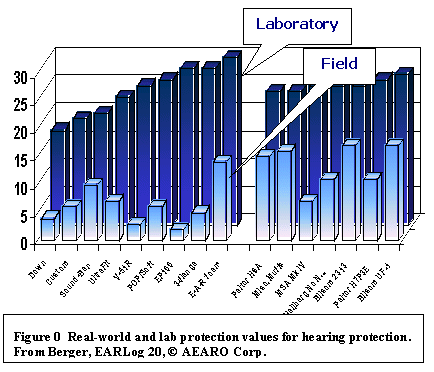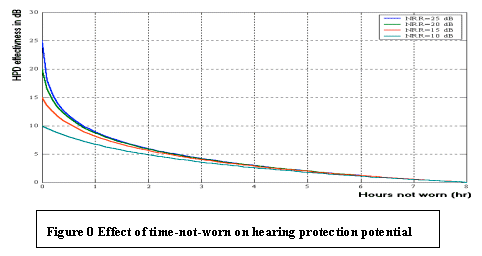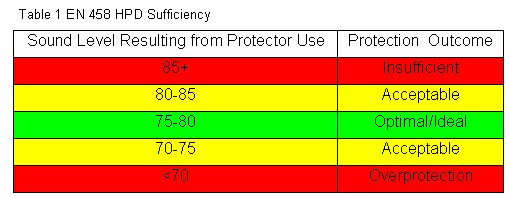Noise-induced hearing loss (NIHL), while irreversible and incurable (at least, at this writing), is absolutely preventable. We have known and understood the basic issues regarding the prevention of hearing loss for years. Why then, is work-related NIHL variously described as "the #1 hidden disability in North America" (World Health Organization) and the most common occupational illness in North America (Centers for Disease Control)?
A key reason for the persistence of NIHL in the USA was the decision by the Occupational Safety and Health Administration (OSHA) in the mid-1980's to permit substitution of hearing conservation programs (HCPs) for noise control. HCPs consist of noise measurement, medical surveillance (audiograms), hearing protection devices (HPDs), data analysis, recordkeeping, and worker training. The fundamental assumption was that the two approaches were basically equal - that HCPs and noise control would yield about the same results in terms of hearing loss prevention. The substitution seemed to make sense, at the time! This decision has resulted in attention being focused on worker-based attempts at exposure control instead of reduction or elimination of noise hazards.
The net result of the OSHA decision was to substitute hearing protection devices (HPDs) for noise control. If the two approaches - noise source control and worker exposure management (HCP) - can, on paper, yield equivalent results, why do we continue to see hearing loss accrue in noise-exposed industrial populations at unacceptable levels?
The Hearing Protector: Problem or Solution?
A wide variety of HPDs are available, but several issues have worked to undermine their effectiveness in practice.

HPDs in the USA must be evaluated for noise reduction rating (NRR) using the ANSI standard (S3.19-1974i) cited in the controlling EPA protocol. While the ANSI standard covering HPD evaluation has been updated several times (most recently in ANSI S12.6-1997ii), the 1974 citation is frozen in time, and remains the controlling regulatory criteria required to qualify HPDs for sale and use in the USA.
The 1974 procedure dictates an approach and process that can provide an accurate assessment of the potential protection offered by the devices under optimal conditions - it is designed exclusively to measure the capability of the HPD.
The difficulty is that the human factors issues involved with using HPD in the real world were not addressed in the original procedure from 1974.
Research studies indicate the hearing protection actually achieved by people using HPDs in noise does not approximate the values derived in the carefully controlled laboratory setting. Figure 1 demonstrates how a range of devices perform in the lab and in the real world.
How can this happen? Not only are the real-world values far less than the lab says, but they don't even correspond - a higher lab value (noise reduction rating, NRR) does not necessarily equate with better or more significant noise protection.
Part of the reason the lab values and the real world values are disparate and highly uncorrelated, is the test itself. Laboratory tests evaluate the optimal protection offered by HPDs in a carefully controlled, short term setting. Issues of human comfort, compliance with workplace rules and regulations, and long-term wearability are not addressed. Trained experimenters fit the HPDs on paid subjects in an artificially perfect laboratory situation. The subjects are paid for their time, and they are tested for a relatively short period of time. The results can be critical to manufacturers, as a small difference in NRR may provide a marketing advantage for the higher rated device.
In essence, the protocol is highly flawed, and predictably, yields results that are essentially invalid for estimating protection offered by the devices in field use.
Various approaches to evaluating HPDs for comfort have been proposed. However, comfort issues, like how well HPDs are tolerated in the workplace, and how long they can or will be worn in noisy environments, are not issues addressed by the current evaluation procedure.

If discomfort results in HPDs being removed by the noise-exposed worker for even a short period of time, the net effect can significantly compromise the actual protection offered by any device. Figure 2 shows the effect of removing hearing protection in noise. Even an HPD with a nominal protection rating of 25 dB will provide no more than 8 dB of protection if removed for an hour a day in noise.
Derating
OSHA's approach to addressing the difference between field studies and lab values is to arbitrarily "derate" hearing protectors by 50%. An NRR of 30 is assumed to provide about 15 dB of real protection. NIOSH has played into this process as well, suggesting in their 1998 Criteria for a Recommended Standard: Occupational Noise Exposureiii a variable derating system based on the type of protector.
Each of these approaches has merit, and each presumes the 1974 protocol is highly inexact, but neither addresses the fundamental issue - even if we use "derating," we simply have no idea how much protection any given worker is getting from their HPD. Or more importantly, we have no idea how much noise exposure the workers are receiving in the real work place!
New technology may help in solving this riddle (see New Developments, below), but for now, how well HPDs work in the workplace is anybody's guess.
Too much of a good thing?
Most of the HPDs on the market today are engineered, designed, and marketed based on maximum protection - after all, if a little protection is good, a lot must be better, right?
Not necessarily. Ninety-seven percent of all noise exposure in the USA industrial setting is less than 100 dB(A)iv. If we consider 85 dB(A) as "safe", as inferred in current US regulations, a reliable 15 dB of protection or less is all that's needed for the vast majority of noise exposures. If an employee exposed to 90 dB properly uses HPDs with a noise reduction rating (NRR) of 28 dB, the net result of 62 dB puts them at a distinct disadvantage while trying to hear warning signals, verbal communication, or their machine.
The European Union in Guideline EN 458v calls this unacceptable situation "overprotection" (see Table 1). Their guidelines, also referenced in the new Canadian hearing protector standardvi, reflect optimum and acceptable ranges of protection. Risk is found on both ends of the scale - too much protection can be as bad as too little. This is an important concept, and has validity.

The Throwaway Effect
Most of the protectors in use today are, while ostensibly reusable, considered by employers and workers as "throwaway" or single use devices. In addition to the hidden financial implications associated with this approach (even a 10¢ protector, thrown away twice a day, has a net annual cost of $50 per user), this approach has subtle implications that do not bode well for the HCP.
Devices with such a small unit cost are more likely than not considered a commodity by purchasing personnel. Selection decisions are not made based on health and safety or sufficiency concerns. Rather, decisions regarding this critical piece of personal protective equipment are made by purchasing agents on the same basis as reams of copy paper. Cost, down to fractions of a cent per pair, is the likely dominant basis for selection of HPD in much of industry. Not noise levels, not comfort, but cost.
In addition, the "least cost versus the best protection" equation sends a message to the worker regarding their hearing, and their value to the company as an employee. The message is, if the employer really cared about the worker's hearing, they would make decisions on the selection and fitting of HPDs based on personal preference, appropriate and sufficient attenuation, and employee protection and comfort, rather than price and ease of purchase.
Typically, HPDs are purchased based on low cost, leaving the selection and fitting to the employee. "Hearing protection? Pick the one you like and read the instructions on the box" - even though the box is back at the tool crib, not on the line where the worker is expected to use the things. Then we wonder why workers don't use HPD properly.
How About the Hearing Impaired?
Current protocols and standards do not consider the hearing ability of the employee (i.e., the HPD user). The assumption is made that everyone has hearing within normal limits - when for many US workers, that is simply not the case.
The compounding effects of HPDs providing overprotection, and less-than-optimal hearing ability can leave the hearing-impaired worker with little residual auditory perception. This can leave them at great risk of missing auditory cues for equipment or co-workers, and can put them at greater risk of industrial accidentsvii.
Some hearing-impaired workers try to use hearing aids as hearing protectors, assuming that the body of the hearing aid will provide protection against workplace noise. Unfortunately, the hearing aid turned on in noise simply increases exposure by amplifying the noise delivered to the hearing system. Turned off, the vents in most hearing aids provide such a significant leak that they provide no protection from noise whatsoeverviii.
Today's Status:
The bottom line is....
- We don't know how much protection workers are getting from the HPDs we provide.
- We don't know if workers can tolerate using HPDs long enough to get sufficient protection from noise.
- If workers use HPDs in accordance with their prescribed Hearing Conservation Program, and if they achieve the NRRs predicted in the lab, they are probably overprotected and cut off from critical auditory content in their work environments.
- We leave HPD selection decisions to purchasing agents - and we leave workers essentially on their own when it comes to fitting and choosing HPDs.
- We treat the normal-hearing and hearing-impaired worker exactly the same.
Several manufacturers are addressing these difficulties with a variety of approaches.
New methods are evolving to permit field testing of insert-type hearing protectors. The Fit-Chek™ system (https://www.dosebusters.com) has proven useful in field evaluation of HPDs. One key benefit is that the process itself helps make workers aware of usage and fitting techniques that could improve the effectiveness of their HPDs. Unfortunately, the time required to perform the entire test has proven difficult to manage in some production environments. Adaptations are currently being evaluated.
Some manufacturers have introduced HPDs designed to provide a high fidelity sound with reduced or limited attenuation, making the HPD more "natural sounding" and addressing the overprotection issue. The Bilsom NST™ line (https://www.cdalloz.com/CDalloz_Internet/hearing/bilnst.htm) and EAR UltraTech or HiFi devices (https://earsc.com/) are designed to provide sufficient attenuation for the vast majority of workplace noise environments, while allowing enough high-frequency sound pass through to make the net perceived sound more natural.
Sonomax (https://www.sonomax.com) has developed an innovative technology to address a number of the on-going barriers to effective HPD implementation.
Our protocol combines a personal, custom fit earplug with software-driven fitting procedures that detail and document the fit of the devices, the amount of protection the individual worker obtains from the HPDs and the appropriate selection of filters to tune the devices to the workers' noise exposure and hearing ability.
Hearing protection can and should be a critical aspect of hearing loss prevention programs in industry and elsewhere. Careful attention to selection and fitting, and the correct amount of attention paid to the workers and the HPD they use can yield significant benefits in preserving the ability of workers to hear.
_____________________________________
iANSI S3.19-1974, Method for the Measurement of Real-Ear Protection of Hearing Protectors and Physical Attenuation of Earmuffs, American National Standards Institute, New York, 1974
iiANSI S12.6-1997, Methods for Measuring the Real-ear Attenuation of Hearing Protectors, American National Standards Institute, New York, 1997
iiiCriteria for a Recommended Standard: Occupational Noise Exposure (NIOSH Publication 98-126)
ivOSHA (1981). "Occup. Noise Exposure; Hearing Cons. Amend.," Fed. Regist. 46(11), 4078-4181.
vHearing Protectors - Recommendations for selection, use, care and maintenance - Guidance Document EN 458, CEN (European Committee for Standardization), March 1993
viHearing Protection Devices - Performance, Selection, Care, and Use, Canadian Standards Association Standard Z94.2-02, July, 2002
viiNoise and Hearing and Powered Industrial Vehicle Incidents, R.R.Anderson, NHCA Conference Proceedings 2002
viiiHearing Aids in Occupational Settings: Safety and Management Issues, T.G.Dolan and J.F.Maurer, Occupational Safety and Health, October 2000.

